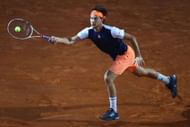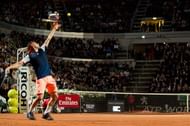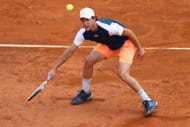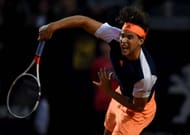For Dominic Thiem, last week has been a roller coaster. He had the match of his career against Rafael Nadal in the quarterfinal of the Rome Masters and then was absolutely clobbered by Novak Djokovic in the semi-final the very next day.
Coming off the back of two back-to-back losses against Nadal, it looked tough for him to overcome the Spaniard on the third try. However, the Austrian turned the tables in his encounter against the ‘King of Clay’ and through his incessant strokeplay and determination, beat him in straight sets.
The next match, however, was a reality check for the 23-year-old as Djokovic took him to the cleaners with a dominant 6-1, 6-0 victory. One day, Thiem was celebrating beating a beast like Nadal on clay, and the next day, he was struggling to send the ball across to the Serb. That’s how fine the line is in sport.
However, Thiem is an exceptional player. He might have lost big to Djokovic, but what he has shown in this tournament, as well as over the past couple of weeks, is that he is one of the bright lights of the future of tennis.
Here’s why he going to be a definitive Roland Garros champion in the coming years –
Best Grand Slam singles result
2016 was a special year for the Austrian. He made his debut in the ATP top 10 rankings, and reached his first Grand Slam semifinal. Incidentally, both of these things happened at the French Open. He beat players like Alexander Zverev, Marcel Granollers and David Goffin to become one of the last four men standing.
Unfortunately, he found himself against the eventual champion Djokovic in the semis, and he could not get the job done against the Serb. However, what is important to note is that Thiem had already played a total of 10 tournaments before coming into Roland Garros – a number most top players don’t touch until the latter stages of the season. Even then, he did not display fatigue of any kind as he went through one opponent after another.
Thiem is one of those players who are known to play the extra tournament, which keeps them alive in the race for London but can quickly result in exhaustion and weariness. However, Thiem manages his schedule perfectly and that was clearly visible in Paris last year.
Love affair with clay courts
After observing Nadal thrive year after year on the red mud of the Roland Garros stadium, it's easy to see that an affinity towards any kind of surface is a blessing for players in the tennis circuit. As soon as that season starts, they are infused with a different kind of confidence, their sense of purpose intensifies, and they bask in a kind of Zen-like focus that they manage to generate on their favourite surface.
The case is the same with Thiem and clay. His love affair with the surface might not be as pink as Nadal’s is, but it definitely has a tinge of rosiness to it.
Of the eight titles that Thiem has won in his still-nascent career, six have been on clay. If that doesn’t display dominance on the surface, what does? His comfort level is at its highest when he feels the mud sticking to his sprinting shoes. When he looks at the ball bouncing right up to his racket, he pounces at it at the drop of a hat.
In fact, Thiem reached the quarterfinal of the first ever ATP tournament that he played, which was the Bet-at-home cup at Kitzbühel. Not surprisingly, that too was on a clay court.
With the Austrian being a mighty member of the ‘NextGen’ and touted to be a future Grand Slam champion, the Roland Garros trophy in his cabinet seems like an inevitability rather than a mere possibility.
Aggressive baseline strokeplay
With his strong, steep-angled backhand, Thiem arguably has the strongest baseline presence from the younger generation. His aggression shows through the power that he generates in every shot and his sharp direction changes work wonders against the best baseliners. Add to that his strong court coverage, and his game becomes awe-inspiring for most players on tour.
Thiem's single-handed backhand works beautifully on both sides of the court and his heavy forehand is a missile down the line.
The clay at Roland Garros will ensure that the ball travels slow and bounces high – a phenomenon that’s ideal for Thiem’s game. His cross-court shots will definitely prosper under the high-bouncing ball and will create problems for his opponents.
One of the best things about Thiem’s baseline-centric play on clay courts is that he mixes it up with serve-and-volley occasionally to create a package that tends to confuse the player playing on the other side of the court.
He beat Rafael Nadal on clay
This year, the Spaniard has been on a pathway to resurgence – he reached the final of the Australian Open and has been on a ‘La Decima mission’ since the clay season began. He won the Monte Carlo Masters before beating Thiem in the finals of the Barcelona Open and the Madrid Open.
He steamrolled through a patchy Djokovic when he beat him in straights in the semi-final of the Madrid Open, and let’s not forget that the Serb was on a seven-match winning streak against the 30-year-old.
It looked like Nadal would go unbeaten through the clay season.
Enter – an inspired Thiem! He not only beat Nadal but did so in straight sets. If Nadal does go on to win the coveted 10th title at Paris this year, Thiem will be the only player to beat him in the 2017 clay season. If that doesn’t say that he is a future Roland Garros champion, what does?
Age on his side
The 23-year-old might not be a teenage Grand Slam winner like Nadal was, but he still has many years of prime health ahead of him. The World No. 7 reached his first semi-final at the biggest stage when he was just 22. With a little more fine tuning, both he and his game will grow exponentially to match up to the highest level of competition.
One thing is for certain – Thiem still has the time to take things slowly, cross every bridge as he comes to it and give himself the chance to improve as well as adapt to the changing scenarios in world tennis.
Roland Garros probably is one of the toughest tournaments to even qualify for, and Thiem has a chance of going deep into the competition not only in the coming future, but also this very year!
What is the foot injury that has troubled Rafael Nadal over the years? Check here




